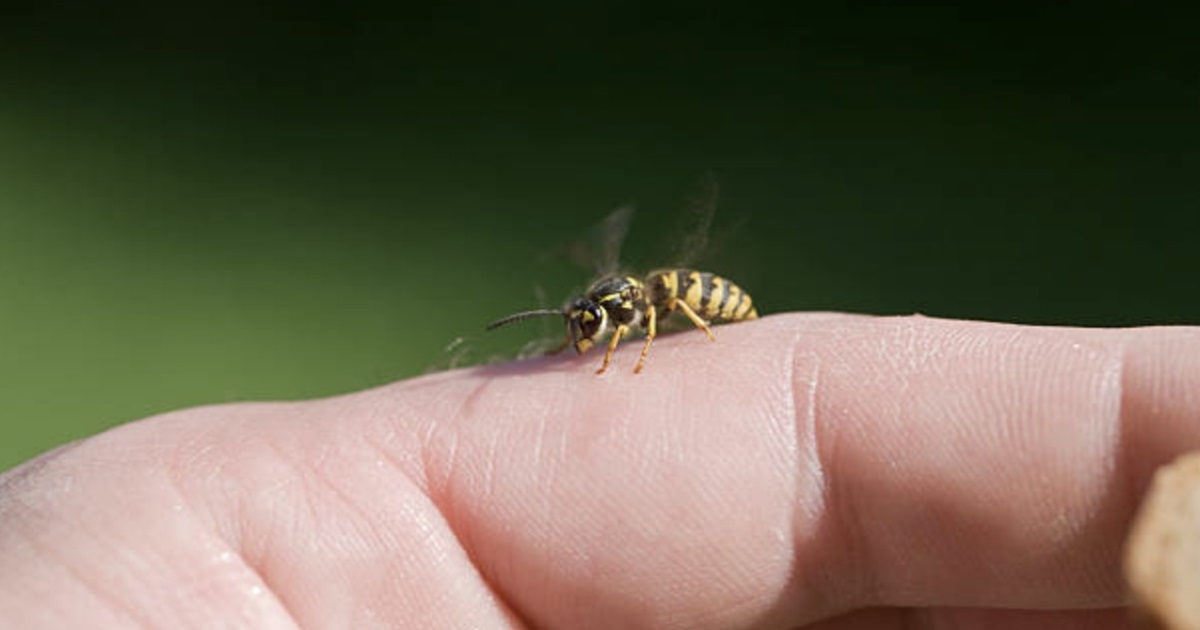
Before we dive into the fix, let’s clarify the difference:
Fur
Fuzzy and gentle-looking
Sleek, smooth, and suspicious
Sting Style
Barbed stinger – only stings once
Smooth stinger – can sting multiple times
Diet
Pollinators – mostly vegetarian
Predators – aggressive and territorial
Temperament
Generally peaceful unless provoked
Will attack if they feel threatened
Bees are fuzzy food heroes.
Wasps are flying alarm systems.
And if you've ever felt that burning, throbbing pain from a sting…
You know exactly what I mean.
⚠️ Signs of a Wasp Sting – What Your Body Might Do Next
Most people experience mild but painful symptoms:
Sharp pain at the sting site
Redness and swelling
Heat and tenderness
Mild itching or throbbing
But some have more serious reactions — and knowing the signs could save your life.
Allergic Reaction Warning Signs:
Swelling beyond the sting area
Could indicate sensitivity
Hives or rash
Histamine response gone wild
Trouble breathing
Seek help immediately
Dizziness or nausea
Possible anaphylaxis
Swelling of lips, tongue, or throat
Call 911 now
If you’ve never been stung before, it’s hard to know how your body will react. That’s why it’s smart to always be prepared — especially if you live in an area where wasps love patios, picnics, and bare feet.
🩹 What to Do Immediately After a Wasp Sting
Step 1: Move Away From the Nest
Don’t panic — but do move quickly out of range. Wasps release pheromones when threatened, which can attract more insects.
Avoid swatting — that makes things worse.
Step 2: Clean the Area
Wash the sting site gently with soap and water to reduce infection risk.
No need to “remove” a stinger — wasps don’t leave them behind.
Step 3: Reduce Pain and Swelling Fast
Apply a cold compress or ice pack wrapped in a cloth to the sting for 10–15 minutes at a time .
This helps:
Numb pain
Slow down swelling
Reduce inflammation
✅ Pro Tip: Elevate the affected limb if possible — it helps minimize puffiness.
Step 4: Soothe the Sting With Natural Remedies
Some home remedies may offer relief — though effectiveness varies person to person.
Baking soda paste
Helps neutralize venom
Honey
Natural antibacterial that soothes irritation
Aloe vera gel
Cools the skin and reduces redness
Apple cider vinegar
Can draw out heat and sting
Toothpaste
Menthol can numb the area temporarily
Use these cautiously — and stop if irritation increases.
Step 5: Watch for Reactions
Even if the sting seems minor at first, monitor it closely for several hours.
If you notice any signs of an allergic reaction — difficulty breathing, rapid swelling, dizziness — seek medical attention immediately .
For kids, elderly individuals, or those with known allergies:
Always keep an EpiPen nearby if prescribed.
And if you’ve never had a severe reaction before…
Still take note.
Your body might surprise you.
💡 Bonus Tips for Preventing Future Stings
Prevention is better than cure — especially if you're already afraid of flying bugs.
Avoid wearing bright colors outdoors
Attracts wasps like a neon sign saying "bite here"
Skip sweet-smelling lotions and perfumes
Mimics flower scents and attracts insects
Don’t eat outside without covering food
Sugary drinks and fruit pull wasps in like magnets
Seal garbage bins tightly
Keeps wasps from nesting near your home
Stay calm and still around wasps
Aggressive movement draws attention
Also, wasps are most aggressive in late summer and early fall — so extra caution is needed during this time.
🏥 When to See a Doctor
Even if you're not allergic, visit a healthcare provider if:
The sting area becomes hot, red, and swollen days later
Pus forms — could be infected
Pain worsens instead of improves
You develop flu-like symptoms
For those with known allergies, seek emergency care immediately — and use an EpiPen if available.
🧼 Final Thoughts: Being Afraid of Wasps Is Totally Normal — But Knowing What to Do Makes It Less Scary
Being scared of wasps doesn't make you weak.
It makes you human.
Their sting hurts.
They don’t warn you before they strike.
And they hover like tiny helicopters of doom.
But now you know what to do — fast and calmly — if one gets you.
From cleaning to cooling to watching for danger signs…
You’ve got the tools to handle it.
So next time you hear that sharp, buzzing sound behind you…
Take a deep breath.
Stay still.
Back away slowly.
Because sometimes, the bravest thing you can do isn’t fight the wasp.
It’s survive the sting.





